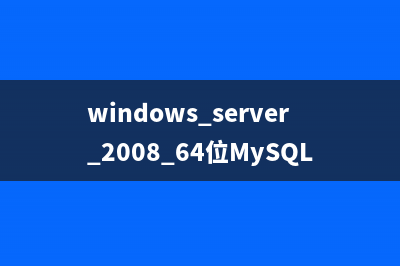位置: 编程技术 - 正文
linux系统中find命令之exec使用介绍(linux里find命令)
编辑:rootadmin推荐整理分享linux系统中find命令之exec使用介绍(linux里find命令),希望有所帮助,仅作参考,欢迎阅读内容。
文章相关热门搜索词:linux系统find命令用法,linux find -name命令详解,linux find -name 命令,linux find -mmin,linux里find命令,linux系统find命令用法,linux系统中find命令,linux系统find命令用法,内容如对您有帮助,希望把文章链接给更多的朋友!
find是我们很常用的一个Linux命令,但是我们一般查找出来的并不仅仅是看看而已,还会有进一步的操作,这个时候exec的作用就显现出来了。
exec解释:
-exec 参数后面跟的是command命令,它的终止是以;为结束标志的,所以这句命令后面的分号是不可缺少的,考虑到各个系统中分号会有不同的意义,所以前面加反斜杠。
{} 花括号代表前面find查找出来的文件名。
使用find时,只要把想要的操作写在一个文件里,就可以用exec来配合find查找,很方便的。在有些操作系统中只允许-exec选项执行诸如l s或ls -l这样的命令。大多数用户使用这一选项是为了查找旧文件并删除它们。建议在真正执行rm命令删除文件之前,最好先用ls命令看一下,确认它们是所要删除的文件。 exec选项后面跟随着所要执行的命令或脚本,然后是一对儿{ },一个空格和一个,最后是一个分号。为了使用exec选项,必须要同时使用print选项。如果验证一下find命令,会发现该命令只输出从当前路径起的相对路径及文件名。
实例1:ls -l命令放在find命令的-exec选项中
命令:
find . -type f -exec ls -l {} ;
输出:
复制代码代码如下:[root@localhost test]# find . -type f -exec ls -l {} ; -rw-r--r-- 1 root root - : ./log.log-rw-r--r-- 1 root root 0 - : ./test4/log3-2.log-rw-r--r-- 1 root root 0 - : ./test4/log3-3.log-rw-r--r-- 1 root root 0 - : ./test4/log3-1.log-rw-r--r-- 1 root root - : ./log.log-rw-r--r-- 1 root root - : ./log.log-rw-r--r-- 1 root root - : ./log.log-rw-r--r-- 1 root root - : ./log.txt-rw-r--r-- 1 root root 0 - : ./test3/log3-2.log-rw-r--r-- 1 root root 0 - : ./test3/log3-3.log-rw-r--r-- 1 root root 0 - : ./test3/log3-1.log[root@localhost test]#
说明:
上面的例子中,find命令匹配到了当前目录下的所有普通文件,并在-exec选项中使用ls -l命令将它们列出。
实例2:在目录中查找更改时间在n日以前的文件并删除它们
命令:
find . -type f -mtime + -exec rm {} ;
输出:
复制代码代码如下:[root@localhost test]# ll总计 -rw-r--r-- 1 root root - : log.log-rw-r--r-- 1 root root - : log.log-rw-r--r-- 1 root root - : log.loglrwxrwxrwx 1 root root 7 - : log_link.log -> log.log-rw-r--r-- 1 root root - : log.log-rw-r--r-- 1 root root - : log.txtdrwxr-xr-x 6 root root - : scfdrwxrwxrwx 2 root root - : test3drwxrwxrwx 2 root root - : test4[root@localhost test]# find . -type f -mtime + -exec rm {} ;[root@localhost test]# ll总计 -rw-r--r-- 1 root root - : log.loglrwxrwxrwx 1 root root 7 - : log_link.log -> log.logdrwxr-xr-x 6 root root - : scfdrwxrwxrwx 2 root root - : test3drwxrwxrwx 2 root root - : test4[root@localhost test]#
说明:
在shell中用任何方式删除文件之前,应当先查看相应的文件,一定要小心!当使用诸如mv或rm命令时,可以使用-exec选项的安全模式。它将在对每个匹配到的文件进行操作之前提示你。
实例3:在目录中查找更改时间在n日以前的文件并删除它们,在删除之前先给出提示
命令:

find . -name "*.log" -mtime +5 -ok rm {} ;
输出:
复制代码代码如下:[root@localhost test]# ll总计 -rw-r--r-- 1 root root - : log.loglrwxrwxrwx 1 root root 7 - : log_link.log -> log.logdrwxr-xr-x 6 root root - : scfdrwxrwxrwx 2 root root - : test3drwxrwxrwx 2 root root - : test4[root@localhost test]# find . -name "*.log" -mtime +5 -ok rm {} ;< rm ... ./log_link.log > ? y< rm ... ./log.log > ? n[root@localhost test]# ll总计 -rw-r--r-- 1 root root - : log.logdrwxr-xr-x 6 root root - : scfdrwxrwxrwx 2 root root - : test3drwxrwxrwx 2 root root - : test4[root@localhost test]#
说明:
在上面的例子中, find命令在当前目录中查找所有文件名以.log结尾、更改时间在5日以上的文件,并删除它们,只不过在删除之前先给出提示。 按y键删除文件,按n键不删除。
实例4:-exec中使用grep命令
命令:
find /etc -name "passwd*" -exec grep "root" {} ;
输出:
复制代码代码如下:[root@localhost test]# find /etc -name "passwd*" -exec grep "root" {} ;root:x:0:0:root:/root:/bin/bashroot:x:0:0:root:/root:/bin/bash[root@localhost test]#
说明:
任何形式的命令都可以在-exec选项中使用。 在上面的例子中我们使用grep命令。find命令首先匹配所有文件名为“ passwd*”的文件,例如passwd、passwd.old、passwd.bak,然后执行grep命令看看在这些文件中是否存在一个root用户。
实例5:查找文件移动到指定目录
命令:
find . -name "*.log" -exec mv {} .. ;
输出:
复制代码代码如下:[root@localhost test]# ll总计 drwxr-xr-x 6 root root - : scfdrwxrwxr-x 2 root root - : test3drwxrwxr-x 2 root root - : test4[root@localhost test]# cd test3/[root@localhost test3]# ll总计 -rw-r--r-- 1 root root - : log.log-rw-r--r-- 1 root root - : log.log-rw-r--r-- 1 root root 0 - : log.log[root@localhost test3]# find . -name "*.log" -exec mv {} .. ;[root@localhost test3]# ll总计 0[root@localhost test3]# cd ..[root@localhost test]# ll总计 -rw-r--r-- 1 root root - : log.log-rw-r--r-- 1 root root - : log.log-rw-r--r-- 1 root root 0 - : log.logdrwxr-xr-x 6 root root - : scfdrwxrwxr-x 2 root root - : test3drwxrwxr-x 2 root root - : test4[root@localhost test]#
实例6:用exec选项执行cp命令
命令:
find . -name "*.log" -exec cp {} test3 ;
输出:
复制代码代码如下:[root@localhost test3]# ll总计 0[root@localhost test3]# cd ..[root@localhost test]# ll总计 -rw-r--r-- 1 root root - : log.log-rw-r--r-- 1 root root - : log.log-rw-r--r-- 1 root root 0 - : log.logdrwxr-xr-x 6 root root - : scfdrwxrwxr-x 2 root root - : test3drwxrwxr-x 2 root root - : test4[root@localhost test]# find . -name "*.log" -exec cp {} test3 ;cp: “./test3/log.log” 及 “test3/log.log” 为同一文件cp: “./test3/log.log” 及 “test3/log.log” 为同一文件cp: “./test3/log.log” 及 “test3/log.log” 为同一文件[root@localhost test]# cd test3[root@localhost test3]# ll总计 -rw-r--r-- 1 root root - : log.log-rw-r--r-- 1 root root - : log.log-rw-r--r-- 1 root root 0 - : log.log[root@localhost test3]#
linux系统find命令之xargs使用实例分享 错误信息通常是参数列太长或参数列溢出。这就是xargs命令的用处所在,特别是与find命令一起使用。find命令把匹配到的文件传递给xargs命令,而xargs命令
linux命令之find命令的个常用参数详解(含具体用法和注意事项) 1.使用name选项:文件名选项是find命令最常用的选项,要么单独使用该选项,要么和其他选项一起使用。可以使用某种文件名模式来匹配文件,记住要
linux命令大全之crontab命令使用详解 at命令是针对仅运行一次的任务,循环运行的例行性计划任务,linux系统则是由cron(crond)这个系统服务来控制的。Linux系统上面原本就有非常多的计划性工
标签: linux里find命令
本文链接地址:https://www.jiuchutong.com/biancheng/356932.html 转载请保留说明!




